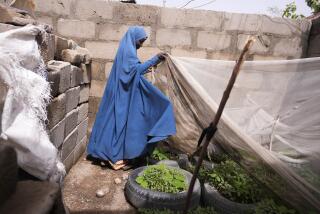Children Vulnerable in Family Poverty
There are numerous ways to say that millions of American women and children are poor:
--Almost half of the poor people in the United States live in families headed by women.
--More than half of the children who live in female-headed households in the United States are growing up in poverty.
--A family with a woman at the head is 4 1/2 times more likely to be poor than a family headed by a man or a married couple.
These are among the findings of a new report from the Ford Foundation, “Women, Children and Poverty in America.”
Below Poverty Line
“Most troubling,” the report authors said, are the 13 million children who live in families that are defined by the federal government as below the poverty line. Young children are the most vulnerable to poverty. Three out of five white children under age 6 in families headed by women are poor. In black and Latino families headed by women, three out of four children are growing up in poverty. (The foundation used government figures from the U.S. Bureau of the Census, which sets the “poverty line” each year as its definition of poverty.)
Equally troubling is the prediction that the problem will increase. Because more couples are divorcing and more women are having children out of wedlock, the numbers of families headed by women with the potential for poverty has more than doubled in the last 25 years. (The incidence of divorce increased by 122% between 1970 and 1982; the incidence of single motherhood by 435%.) The White House Select Committee on Children, Youth and Families estimates that the number of children under 10 living in families headed by women will rise by 48% between 1980 and 1990.
The foundation identified other social trends that lead to poverty for children. For example, it found that while the number of babies born to teen-agers has declined from a high in the mid-1950s, an increasing proportion of pregnant teens keep their babies and do not marry. These are the parents most likely to suffer a lifelong economic disadvantage, according to the report.
Surprisingly, while the number of poor families has increased, the number of such families receiving welfare benefits (primarily Aid to Families with Dependent Children), has remained stable since 1972, after doubling twice between 1947 and 1971.
No ‘Typical’ Family
There is no such thing as a “typical” welfare family. “The mothers heading AFDC families are by no means a homogenous group,” the report said. One in four has never worked and one in three has a ninth-grade education or less, but an equal number are working and have high school diplomas. Almost half have only one child and about half receive welfare for only short periods as a temporary source of support following divorce, job loss or the death of a spouse. It could be safely said that everyone whose sole income is AFDC lives in poverty. Because of differing state laws, eligibility and benefits vary from state to state. In Mississippi, a mother with two children receives $96 a month. The typical AFDC family in California is a single parent with two children receiving $426 a month.
Seeking Solutions
The foundation will use the detailed study of who is poor and why to design programs aimed at achieving lasting solutions. One group of projects it funds is “roughly split” between two areas: exploring how public assistance can be improved and preventing the creation of families headed by adolescents. Other funding to improve women’s economic status goes to programs that deal with sex discrimination in employment, infant health, remedial education for out-of-school youth, day care and development assistance for poor communities.
A major foundation interest is to foster the transition of recipients from welfare to work. One innovative project attempts to provide more stable employment and greater career opportunities for home health-care workers. This is a low-income group that encompasses a large number of female workers who tend to move back and forth between work and welfare, or earn so little they combine the two.
Another project, which has received $3.7 million in foundation funds, includes four demonstration projects designed to help teen parents become economically self-sufficient. One aspect of these projects is the “mentor” program that pairs each teen-ager with an older woman in the community who can offer guidance and incentive.
Copies of the foundation data on poverty and listings of foundation projects are available by writing Ford Foundation, Office of Reports, 320 East 43rd St., New York, N.Y. 10017.
More to Read
Sign up for Essential California
The most important California stories and recommendations in your inbox every morning.
You may occasionally receive promotional content from the Los Angeles Times.










